| |
|
Xiamen Oil Paintings, Wholesale Direct!
|
|
100% hand painted, 100% cotton canvas, 100% money back if not satisfaction. |
|
|
|
|
ART WORKS INDEX
A
B
C
D
E
F
G
H
I
J
K
L
M
N
O
P
Q
R
S
T
U
V
W
X
Y
Z
|
|
ARTISTS INDEX
A
B
C
D
E
F
G
H
I
J
K
L
M
N
O
P
Q
R
S
T
U
V
W
X
Y
Z
|
|
|
|
 |
arnold schoenberg
|
|
Period: Modern (1910-1949)
Country: Austria/USA
Born: September 13, 1874 in Vienna, Austria
Died: July 13, 1951 in Los Angeles, CA
Genres: Band Music, Chamber Music, Choral Music, Concerto, Keyboard Music, Miscellaneous Music, Opera, Orchestral Music, Vocal Music
|
|
 |
Arnold Houbraken
|
|
(28 March 1660 - 14 October 1719) was a Dutch painter and writer from Dordrecht, now remembered mainly as a biographer of artists from the Dutch Golden Age. He had ten children. His son Jacobus Houbraken (1698-1780) was an engraver of portraits and book illustrations, including books by his father. His daughter Antonina Houbraken also became an engraver for an Amsterdam publisher, and is known today for her embellishment of cityscapes and buildings with animals and people.
Houbraken was sent first to learn threadtwisting from Johannes de Haan, who introduced him to engraving. After two years he then studied art with Willem van Drielenburch, who he was with during the rampjaar, the year 1672. He then studied 9 months with Jacobus Leveck and finally, four years with Samuel van Hoogstraten. In 1685 he married Sara Sasbout, and around 1709 he moved from Dordrecht to Amsterdam. Arnold Houbraken painted mythological and religious paintings, portraits and landscapes.
|
|
 |
Arnold Genthe
|
|
German-born American Photographer, 1869-1942,German-born American photographer who received a doctorate in philology and linguistics from Jena University in 1894. As a photographer he was self-taught, and is probably best known for his pictures of Chinatown in San Francisco (1896-1906), where he opened a portrait studio in 1897, two years after arriving in America. Although his studio and equipment were destroyed in the 1906 earthquake, his prints survived and the Chinatown photographs were published in 1908. In that year he also started making autochromes. Genthe travelled widely in South America, Japan, and Germany, photographing landscapes and architecture, and in 1910 exhibited at the International Exhibition of Pictorial Photography in Buffalo organized by Alfred Stieglitz. Relocating to New York in 1911, he flourished as a celebrity portraitist. He also became celebrated for his dance photographs, published in The Book of Dance (1916) and Impressions of Isadora Duncan (1929). His autobiography,
|
|
|
|
 |
Arnold Boonen
|
|
Arnold van Boonen was a Dutch eminent portrait painter, was born at Dordrecht, in the Dutch Republic in 1669. He was first a scholar of Arnold Verbius, and was later instructed by Godefried Schalken. He painted genre pictures in the style of the latter, representing subjects by candlelight, but met with such encouragement in portrait painting that he devoted himself almost wholly to that branch of art. His style was well adapted to succeed in it. An excellent oolourist, a faithful designer of his model, and highly skilled, he was soon distinguished as one of the ablest artists of his day. He painted a great number of portraits of the most distinguished people of his time, among whom were Peter the Great, the Elector of Mentz, the Landgrave of Hesse-Darmstadt, the Prince and Princess of Orange, the great Duke of Marlborough, and several others. He painted some large pictures for the halls of the different companies at Amsterdam and Dordrecht. He died in 1729.
The Dresden Gallery has seven works by him, and the 'Woman Singing' in the Lille Gallery is also attributed to him. His son, Kasper van Boonen, also painted portraits, but in no way proved himself equal to his father.
|
|
 |
Arnold Bocklin
|
|
Swiss
1827-1901
Arnold Bocklin Locations
Arnold Bocklin was born on Oct. 16, 1827, in Basel. He attended the Dusseldorf Academy (1845-1847). At this time he painted scenes of the Swiss Alps, using light effects and dramatic views subjectively to project emotional moods into the landscape. In 1848 this romantic introspection gave way to plein air (open-air) objectivity after he was influenced by Camille Corot, Eugene Delacroix, and the painters of the Barbizon school while on a trip to Paris. But after the February and June revolutions Bocklin returned to Basel with a lasting hatred and disgust for contemporary France, and he resumed painting gloomy mountain scenes.
In 1850 Bocklin found his mecca in Rome, and immediately his paintings were flooded by the warm Italian sunlight. He populated the lush southern vegetation, the bright light of the Roman Campagna, and the ancient ruins with lonely shepherds, cavorting nymphs, and lusty centaurs. These mythological figures rather than the landscapes became Bocklins primary concern, and he used such themes as Pan Pursuing Syrinx (1857) to express the polarities of life: warm sunshine contrasts with cool, moist shade, and the brightness of womans spirituality contrasts with mans dark sensuality.
When Bocklin returned to Basel with his Italian wife, he completed the painting which brought him fame when the king of Bavaria purchased it in 1858: Pan among the Reeds, a depiction of the Greek phallic god with whom the artist identified. He taught at the Academy of Art in Weimar from 1860 to 1862, when he returned to Rome. Called to Basel in 1866, he painted the frescoes and modeled the grotesque masks for the facade of the Basel Museum.
Bocklin resided in Florence from 1874 until 1885, and this was his most active period. He continued to explore the male-female antithesis and painted religious scenes, allegories of Natures powers, and moody studies of mans fate. He ceased working with oils and began experimenting with tempera and other media to obtain a pictorial surface free of brushstrokes.
Bocklin spent the next 7 years mostly in Switzerland, with occasional trips to Italy; he devoted much of his energy to designing an airplane. Following a stroke in 1892, he returned to Italy, bought a villa in Fiesole, and died there on Jan. 16, 1901. Many of his late works depict nightmares of war, plague, and death.
|
|
|
|
|
|
|
|
|
|
 |
Armand guillaumin
|
|
French Impressionist Painter, 1841-1927
French painter and lithographer. He grew up in Moulins, but at 16 he returned to Paris to find work. Despite the opposition of his working-class family, he prepared for an artistic career while he supported himself in municipal jobs. He started drawing classes and then enrolled in the Academie Suisse, where he met Cezanne and Camille Pissarro. Guillaumin began his career as an avant-garde artist by exhibiting with them at the Salon des Refus's in 1863.
|
|
 |
Arman Manookian
|
|
(1904 - 1931) was an Armenian-American painter. He was the oldest of three children born to a Christian Armenian family in Constantinople. As a teenager, he survived the Armenian Genocide. Manookian immigrated to the United States in 1920, at the age of 16, and studied illustration at the Rhode Island School of Design. He also took classes at the Art Students League of New York before enlisting in the United States Marine Corps in 1923. While serving in the U. S. Marine Corps he was assigned as a clerk to the author and historian, Major Edwin North McClellan. In 1925, McClellan and Manookian were transferred to Pearl Harbor. The latter supplied illustrations for Leatherneck Magazine and produced about 75 ink drawings for McClellanes history of the United States Marine Corps, which was never published. These drawings are now in the collection of the Honolulu Academy of Arts.
In 1927, Manookian was honorably discharged from the Marine Corps, but remained in Hawaii. He worked for the Honolulu Star-Bulletin and for Paradise of the Pacific.
His paintings are rare and highly valued due to his early death, by suicide, in 1931, and fewer than 30 are in existence. The Honolulu Academy of Arts held a memorial exhibition shortly after Manookianes death and a retrospective exhibition titled Meaning in Color/Expression in Line: Arman Manookianes Modernism Nov. 4, 2010 through April 24, 2011. The Bishop Museum and the Honolulu Academy of Arts are among the public collections holding works by Arman T. Manookian. According to the State of Hawaii's House of Representatives, he is "known as Hawaii's Van Gogh".
In early 2010 a group of seven Manookian paintings owned by the Hotel Hana-Maui were removed from public display. They were the only Manookian oil paintings known to be on public display anywhere in the world. Two of the murals, Red Sails and Hawaiian Boy and Girl, are now on long-term loan to the Honolulu Academy of Arts.
|
|
 |
Arkhip Kuinji
|
|
was originally a Greek,Then he got to St. Petersburg1842 - 1910
|
|
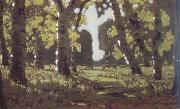 |
Arkhip Ivanovich Kuindzhi
|
|
Russian Painter, 1842-1910
Ukrainian painter, active in Russia. Initially self-taught as an artist, he twice failed the St Petersburg Academy's entrance examination, despite coaching by the marine painter Ivan Aivazovsky. In 1868, however, he was accepted as an external student. He persevered against conservative prejudice and poverty throughout his early career, supplementing his income by retouching photographs. In his early landscape paintings he often sought to capture seasonal moods, as in Autumn Mud (1872; St Petersburg, Rus. Mus.). A more human focus, however, is noticeable after 1874, when he joined the travelling exhibitions society the WANDERERS: the village houses dominate the landscape setting in Evening in Ukraine (1878; St Petersburg, Rus. Mus.). Kuindzhi's principal interest, however, was in lighting, and he obtained striking effects by using vivid colours, chiaroscuro contrasts and simple but cleverly conceived designs. Spectacular paintings, such as the Birch Grove (1879; Moscow, Tret'yakov Gal.), greatly moved contemporary viewers. Through years of experimentation, Kuindzhi developed a highly original technique, which he applied to an increasingly typical, at times almost visionary, treatment of subjects such as snow-covered mountains and moonlight (e.g. Elbnis: Moonlit Night, 1890-95; Moscow, Tret'yakov Gal.). Due to imperfections in the paints he used, many of his canvases soon darkened.
|
|
 |
Arkady Rylov
|
|
(Russian: 29 January 1870 - June 22, 1939) was a Russian and Soviet Symbolist painter.
Rylov was born in the village Istobenskoye, Vyatka gubernia. He was brought in the family of his stepfather, a notary (Rylov's father had a psychiatric illness). He moved to Saint Petersburg and studied at the Technical Design School of Baron Schtiglitz (1888-1891), then at the Imperial Academy of Arts under Arkhip Kuindzhi (1894-1897).
Rylov was a member of the Mir iskusstva movement and its spin-off Union of Russian Artists also a member of the Association of Artists of the Revolutionary Russia. He was a chairman of the Kuindzhi Society.
He started as a historical painter (his graduation work in the Imperial Academy of Arts was Assault of Pechenegs on a Slav village but became a predominately landscape painter. Still many of his paintings have some allusions with Russian history.
Many of his landscapes painted after the October Revolution were seen as symbols of the revolutionary Freedom. At that time he also painted some typical Socialist Realism compositions like Lenin in Razliv. He taught in the Academy of Arts. In his studio he created almost a small nature reserve. There lived squirrels, rabbits, monkey Manka and many wild birds (without cages) and two anthills. According to Mikhail Nesterov wild animals and birds loved Rylov and often came to his studio.
|
|
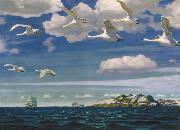 |
Arkady Alexandrovich Rylov
|
|
Arkady Alexandrovich Rylov (Russian, 29 January [O.S. 17 January] 1870 - June 22, 1939) was a Russian and Soviet Symbolist painter.
Biography
Rylov was born in the village Istobenskoye, Vyatka gubernia. He was brought in the family of his stepfather, a notary (Rylov's father had a psychiatric illness). He moved to Saint Petersburg and studied at the Technical Design School of Baron Schtiglitz (1888-1891), then at the Imperial Academy of Arts under Arkhip Kuindzhi (1894-1897).
In the Blue Expanse, 1918Rylov was a member of the Mir iskusstva movement and its spin-off Union of Russian Artists also a member of the Association of Artists of the Revolutionary Russia. He was a chairman of the Kuindzhi Society.
|
|
 |
aristotle
|
|
Born: 384 B.C.
Birthplace: Stagira, Greece
Died: 322 B.C.
Best Known As: The author of Ethics
|
|
 |
Aristide Maillol
|
|
1861-1944 Banyuls-sur-Mer,was a French Catalan sculptor and painter. Maillol was born in Banyuls-sur-Mer, Roussillon. He decided at an early age to become a painter, and moved to Paris in 1881 to study art. After several applications, his enrollment in the Ecole des Beaux-Arts was accepted in 1885, and he studied there under Jean-Leon Gerome and Alexandre Cabanel. His early paintings show the influence of his contemporaries Pierre Puvis de Chavannes and Paul Gauguin. Gauguin encouraged his growing interest in decorative art, an interest that led Maillol to take up tapestry design. In 1893 Maillol opened a tapestry workshop in Banyuls, producing works whose high technical and esthetic quality gained him recognition for renewing this art form in France. He began making small terra cotta sculptures in 1895, and within a few years his concentration on sculpture led to the abandonment of his work in tapestry. The subject of nearly all of Maillol's mature work is the naked female body, treated with a classical emphasis on stable forms. The figurative style of his large bronzes is perceived as an important precursor to the greater simplifications of Henry Moore and Alberto Giacometti, and his serene classicism set a standard for European (and American) figure sculpture until the end of World War II. His important public commissions include a 1912 commission for a monument to Cezanne, as well as numerous war memorials commissioned after World War I. He died in Banyuls at the age of eighty-three, in an automobile accident.
|
|
 |
Arifi
|
|
The Sixteenth century Ottoman court poet
|
|
 |
Arent De Gelder
|
|
1645-1727
was one of Rembrandt's last pupils while in Amsterdam, studying in his studio from 1661 to 1663. He was not only one of the most talented of Rembrandt's pupils, but also one of his most devoted followers, for he was the only Dutch artist to paint in the tradition of Rembrandt's late style into the 18th century.
|
|
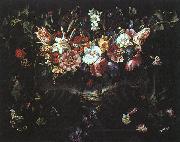 |
Arellano, Juan de
|
|
Spanish Baroque Era Painter, 1614-1676
Spanish painter. He was the pre-eminent painter of flower-pieces in 17th-century Spain. Although Spaniards of the previous generation had painted such works, it was the inspiration of Flemish and Italian examples in Madrid that from c. 1650 encouraged Arellano's success as a specialist in this genre. According to Palomino, who moved to the Court shortly after the artist's death and befriended many painters who had known him, Arellano began to paint flowers only in his thirties after a beginning that showed little promise.
|
|
 |
ARCIMBOLDO, Giuseppe
|
|
Italian Mannerist Painter, ca.1530-1593
Italian painter, draughtsman and tapestry designer, active also in Austria and Bohemia. He came from a distinguished Milanese family that included a number of archbishops of the city; his father was the painter Biagio Arcimboldo. Giuseppe is first documented in 1549, working with his father for Milan Cathedral; he received payments until 1558 for supplying paintings, designs for an altar baldacchino and stained-glass windows for the cathedral: the Story of Lot and the Life of St Catherine in the south transept windows are usually attributed to him. He collaborated with Giuseppe Meda in designing the gonfalone of St Ambrose in Milan, probably sometime soon after 1558. In 1556 he received a commission to paint the south wall and vault of the south transept of Monza Cathedral, also in Lombardy, a work that must have been completed by 1562. Portions of a fresco of the Tree of Jesse on the south wall there can be attributed to him. In 1558 he was paid for designing tapestries for Como Cathedral (in situ). On the basis of stylistic comparison with the windows in Milan and the frescoes in Monza, the design of a tapestry representing St John the Baptist Preaching and Baptizing (Monza, Mus. Duomo) can be attributed to Arcimboldo. The Archbishop of Milan, Carlo Borromeo, probably paid for this tapestry.
|
|
|
|
|
|
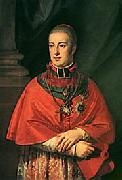 |
Archduke Rudolf of Austria
|
|
Rudolf Johannes Joseph Rainier von Habsburg-Lothringen, Archduke and Prince Imperial of Austria, Prince Royal of Hungary and Bohemia (8 January 1788 - 24 July 1831) was a Cardinal, an Archbishop of Olomouc, and a member of the House of Habsburg-Lorraine.
Born in Pisa, Italy, he was the youngest son of Emperor Leopold II and Maria Louisa of Spain. He was elected archbishop of Olomouc in 1819 and became cardinal in the year 1820.
In 1803 or 1804, Rudolf began taking lessons in piano and composition from Ludwig van Beethoven. The two became friends, and Rudolph became a supporter and patron of Beethoven; their meetings continued until 1824. Beethoven dedicated 14 compositions to Rudolph, including the Archduke Trio, the Hammerklavier Sonata, the Emperor Concerto and the Missa Solemnis. Rudolph, in turn, dedicated one of his own compositions to Beethoven. The letters Beethoven wrote to Rudolph are today kept at the Gesellschaft der Musikfreunde in Vienna.
On 24 March 1819 he was appointed, at the age of 31, Archbishop of Olomouc in the present day Czech Republic but then part of the Austrian Empire. He was made Cardinal-Priest of the titular church of S. Pietro in Montorio by Pope Pius VII on 4 June 1819. He was ordained a priest on 29 August 1819, and consecrated a bishop on 26 September.
In 1823 - 24, he was one of the 50 composers who composed a variation on a waltz by Anton Diabelli for Vaterländischer Kenstlerverein. In Rudolf's case, the music was published anonymously, as by "S.R.D" (standing for Serenissimus Rudolfus Dux).
|
|
|
|
 |
Arborelius
|
|
Olof Arborelius
Olof Arborelius 1842-1915
|
|
 |
ARALDI, Alessandro
|
|
Italian Painter, ca.1460-1530
He apparently assisted with contemporary Cristoforo Caselli (il Temperello). His work shows the influences of early Venetian Renaissance painters such as Giovanni Bellini and Vivarini, but also Lorenzo Costa from Ferrara. He painted frescoes in the Benedictine monastery of San Paolo. He also painted two scenes with the story of St. Catherine, the Dispute before the emperor Maximilian and St. Catherine and St. Jerome, including an odd Annunciation (1514), for the abbess Giovanna da Piacenza (1514). Antonio Allegri (Correggio) would complete his own masterpiece frescoes for the abbess in a strikingly different, and for the age, more modern, style.
|
|
|
|
|
|
|
|
Apollonio di Giovanni
|
|
ca.1415-1465
Italian painter and illuminator. He was trained by illuminators in the circle of Bartolomeo di Fruosino and Battista di Biagio Sanguini (1393?C1451) and became a member of the Arte dei Medici e degli Speziali in 1442 and of the Compania di S Luca in 1443. Apollonio was influenced by Filippo Lippi, Lorenzo Ghiberti and Paolo Uccello.
|
|
|
|
|
|
|
|
 |
Antoon Claeissens
|
|
(his name is given in many varieties, with his first name rendered as Anton, Anthonie, Anthony, Anthuenis, and his surname as Claes, Claesz, Claeis, Claeiss, Claessens and Claeissins), the son of Pieter Claes the elder, painted historical and allegorical subjects, and portraits. He was a native of Bruges, and there entered the Guild of St. Luke in 1575, and became its dean in 1586, 1590, and 1601. He died in 1613. His works, several of which are in the Hôtel-de-Ville and churches of Bruges, are distinguished by their fine colouring and finish. In the H6tel-de-Ville is a 'Grand Banquet' with many portraits of magistrates of the time, dated 1574.
His son, Pieter Anthonie, was dean of the Guild of St. Luke at Bruges in 1607, and died in 1608.
|
|
|
|
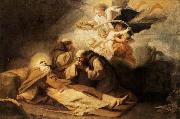 |
Antonio Viladomat y Manalt
|
|
Spanish, 1678-1755,Spanish Catalan painter. He was the most significant figure in Catalan painting from the end of the 17th century to the first half of the 18th. He trained with P. B. Savall and J. B. Perram?n in Barcelona. The arrival of the Archduke Charles (later Charles VI) of Austria in Barcelona in 1703 as a pretender to the throne during the War of the Spanish Succession (1702-13), accompanied by such Italian artists as Ferdinando Galli-Bibiena, acquainted Viladomat y Manalt with artistic trends in Italy. He experienced problems with the artists' guild in Barcelona because of his refusal to participate in the traditional work system. Despite this, his workshop-academy became a centre for the training of numerous painters, sculptors and engravers. Viladomat y Manalt was principally a religious painter, and his oil paintings include Christ Appearing to St Ignatius of Loyola (c. 1711-20; Barcelona, Jesuit Convent) and St Augustine and the Holy Family (Madrid, Prado). He also painted such murals as the tempera Angels with the Sudarium (c. 1727; Matare, S Mar?a, Capilla de los Dolores), but most of the others have disappeared. He painted an extensive series of monastic and evangelical works, in which his revival of compositions characteristic of the Spanish Golden Age is apparent. Examples include the Stigmatization of St Francis (c. 1724; Barcelona, Mus. A. Catalunya), part of a cycle of paintings on the life of St Francis commissioned for the cloister of the convent of S Francisco de As?s in Barcelona. His late Baroque style is related to the severe and realistic trend in Spanish painting in the early 17th century. Some interesting profane allegories by the artist are extant, notably the series Four Seasons (c. 1720-30; Barcelona, Mus. A. Catalunya), which consists of landscapes with genre scenes. Several of the still-lifes by Viladomat y Manalt such as the realistic Still-life with Dead Turkey (Barcelona, Mus. A. Catalunya), which has strong contrasts of light, bear an affinity with Neapolitan painting of the last decades of the 17th century.
|
|
|
|
|
|
|
|
|
|
|
|
 |
Antonio Ponce
|
|
Spanish, 1608-1662,Spanish painter. He had an undistinguished career in Madrid as a painter of still-lifes and flower-pieces. In 1624 Ponce was apprenticed to Juan van der Hamen y Leen, whose niece he married in 1628. The format of Ponce's compositions and some of his motifs derive from works by van der Hamen, though lacking their subtlety of composition, spatial clarity and formal conviction. In Vase of Flowers, signed and dated 1650 (Strasbourg, Mus. B.-A.), Ponce's style shows laboured imitation of van der Hamen's: his dry execution results in a paradoxically airless and petrified quality. Ponce was always a derivative artist, and some of his still-lifes with seasonal themes are similar to works by Francisco de Barrera, another modest painter with whom he was documented in the 1630s. Paintings from the 1640s and 1650s depicting baskets of fruit and bunches of grapes against light backgrounds are characterized by compositional informality, softer lighting and freer brushwork, through which Ponce attempted to convey the textures of objects and endow the subject with greater naturalness.
|
|
 |
Antonio Pollaiuolo
|
|
1431-1498 Italian Antonio Pollaiuolo Galleries
Sculptor, painter, designer and engraver. He was trained as a goldsmith and bronze sculptor, probably in Lorenzo Ghiberti workshop. In 1466 he joined the Arte della Seta, the silkworkers guild (to which goldsmiths traditionally belonged), and he listed himself as a goldsmith and painter in the membership records of the Compagnia di S Luca in 1473; this is the only documented reference to him as a painter. In his tax return in 1480 he reported that he was renting a workshop specifically for goldsmiths work. He still described himself as a goldsmith, and not as a painter, in his last tax return in 1496.
|
|
|
|
 |
Antonio Pisanello
|
|
1395-1451 Italian Antonio Pisanello Galleries
professionally as Antonio di Puccio Pisano or Antonio di Puccio da Cereto, also erroneously called Vittore Pisano by Giorgio Vasari, was one of the most distinguished painters of the early Italian Renaissance and Quattrocento. He was acclaimed by poets such as Guarino da Verona and praised by humanists of his time who compared him to such illustrious names as Cimabue, Phidias and Praxiteles.
He is known for his resplendent frescoes in large murals, elegant portraits, small easel pictures, and many brilliant drawings. He is the most important commemorative portrait medallist in the first half of the 15th century.
He was employed by the Doge of Venice, the Pope in the Vatican and the courts of Verona, Ferrara, Mantua, Milan, Rimini, and by the King of Naples. He stood in high esteem of the Gonzaga and Este families.
He had many of his works wrongly ascribed to other artists such as Piero della Francesca, Albrecht Durer and Leonardo da Vinci, to name a few. While most of his paintings have perished, a good many of his drawings and medals have survived.
|
|
 |
Antonio Parreiras
|
|
(1860 - 1937) was a Brazilian painter. Although much of his work was made up of historical and nude paintings, he expressed himself best in his landscapes, which combined European influences with those of his native Brazil.
In 1883, Parreiras met German painter George Grimm, who taught landscape, flora and wildlife painting, while studying at Brazil's Fine Arts Imperial Academy. Grimm influenced Parreiras to move away from academic traditions of painting in favor of the direct observation of nature, free brushstrokes and luminosity.
Parreiras traveled throughout Europe for a number of years, visiting many countries including Germany, Italy, and France, exhibiting his first female nude at the Salon in Paris in 1907. He continued to visit Europe after permanently returning to Brazil in 1914, and in 1929 received a gold medal in the Exposition International in Seville.
Parreiras also founded the Plein Air School in Niterei, Brazil, and a museum holding many of his works, the Museum Antônio Parreiras, is also in Niterei.
|
|
|
|
|
|
 |
Antonio Maria Fabres y Costa
|
|
Spanish, 1854 - 1936
Antonio Fabres was a famous Spanish artist during the turn of the century. He was born in Barcelona Spain in 1854. It is said that he was the artist gene since his father was a draughtsman and his uncle a silversmith. He started studying at the Escuela de Bellas Artes in his native city at the age of 13. When he turned 21, he received a grant to study in Rome. There are records of his sculptures from early in his career but later on he became a painter almost exclusively. He joined Mariano Fortuny with a group that became known for their intense realism. Their popularity grew with the taste of the bourgeoisie seeking exotic images with oriental of medieval themes. He went back to Barcelona in 1886 and in 1894 he moved to Paris. The popularity he had earned during his decade in Italy helped him open a large studio where he could create complex scenes for the upper classes.
In 1902 the Academia de San Carlos decided to renovate their classical techniques with the ones of realism that were so popular in Europe at the time. Antonio Fabres was called to take the place of Santiago Rebull as head of this important institution. Although some of his students went on to become what was later known as the Post-Revolutionary Movement in Mexican art, the faculty had a hard time adapting to his distinct style and personality. In 1907, he returned to Rome. One of his last commissions in Mexico was the decorations of a hall at the Porfirio Diaz mansion where he mainly focused on art nouveau style .
Fabres was recognized most everywhere he traveled. He was acclaimed in Barcelona, London, Paris, Vienna and Lyon. At the end of his life he was dealt a very unfortunate blow when in 1926 he decided to donate a large amount of works to the Museo de Bellas Artes de Barcelona. In exchange for this generous donation he asked the Museum that a hall be built with his name, but the museum never built that hall and although he protested several times, they could never settle the argument. Antonio Fabres died in Rome in 1938.
|
|
|
|
|
|
|
|
|
| Wholesale China Oil Painting Wholesale Oil Painting China Xiamen Portrait Reproduction on canvas Chinese Oil Painting Wholesale USA Oil Painting |
|
|
|
|
|